Hol Dir den wöchentlichen SPARTANAT-Newsletter.
Dein Bonus: das gratis E-Book von SPARTANAT.
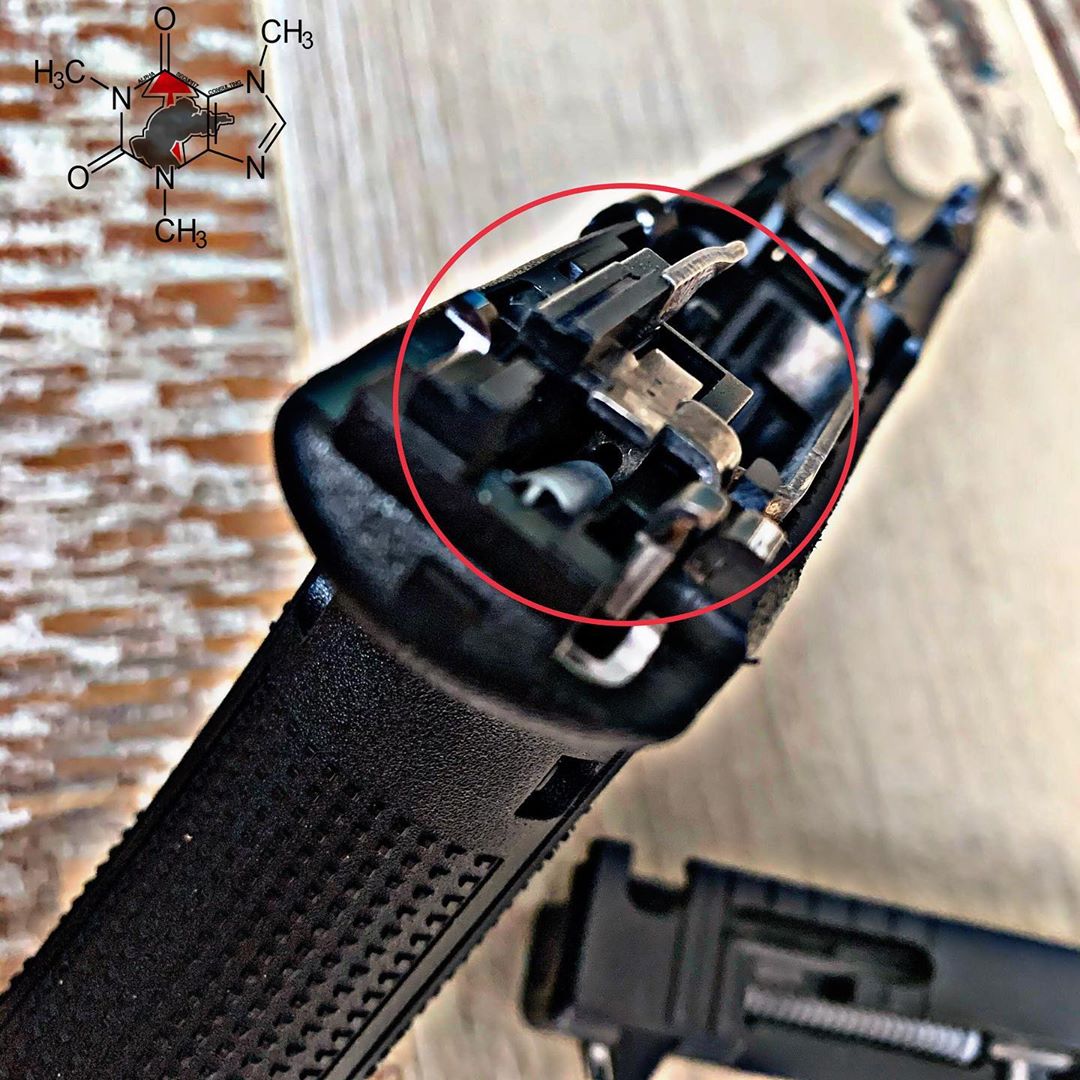
WAFFENTECHNIK: DAS IST MEINE SICHERUNG (2)
SPARTANAT veröffentlicht heute den letzten Artikel von Markus Altoé, den wir betrauern - HIER ist die Nachruf für Markus. Markus hat uns unerwartet und viel zu früh verlassen.
SPARTANAT bringt euch heute den letzten Artikel von Markus Altoé, um den wir trauern – HIER der Nachruf auf Markus. Überraschend und viel zu früh ist Markus von uns gegangen. In seinem Beitrag, den wir hier posthum veröffentlichen, behandelt Markus das komplexe Thema Sicherungen bei Schusswaffen. Das hier ist der zweite Teil der dreiteiligen Serie über Sicherungen von Waffen, den Markus mit großer Sachkenntnis verfasst hat.
Sicherungen bei Schusswaffen – Die Schlagfedersicherung
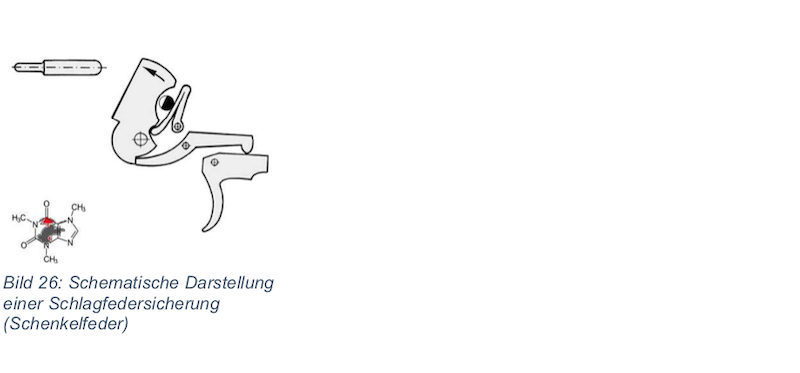
Schlagfedersicherungen sichern (blockieren) die Schlagfeder und verhindert die Einwirkung der Schlagfeder auf das Schlagstück (siehe Bild 26). Bei der Schlagfeder handelt es sich um eine Schenkelfeder. Schlagfedersicherungen findet man ausschließlich bei selbstspannenden Kipplaufwaffen.
Beim Brechen einer Kipplaufwaffe wird das Schloss durch den innenliegenden Spannhebel und den Vorderschaft gespannt; d.h. die Schlagfeder (oder Schlagfedern bei Waffen mit mehreren Schlagstücken z.B. Drilling) spannt das Schlagstück (bzw. die Schlagstücke bei Waffen mit mehreren Schlagstücken). Dabei wird ein Sperrschieber durch die Verschlusswelle vor die Schlagfeder (Schenkelfeder) geschoben. Die Freigabe der über die Schlagfeder vorgespannten Schlagstücke (und somit auch der Schlagfeder) erfolgt über den Abzug.
Moderne Schlosse (z.B. bei StrikerFire Pistolen) nutzen Schraubenfedern anstelle der Schenkelfedern. Das ermöglicht neue Konstruktionen, diese werden als Sicherheitssysteme bezeichnet.
Sicherungen bei Schusswaffen – Die Schlagstücksicherung
Schlagstücksicherungen sichern (blockieren) das Schlagstück, z.B. mit Hilfe einer
Sicherungswelle. Diese greift in eine Aussparung des Schlagstückes und hält so das Schlagstück fest. Beim Entsichern dreht sich die Sicherungswelle aus der Aussparung im Schlagstück und der Schuss kann brechen.
Theoretisch bieten Schlagstücksicherungen mit die größte Sicherheit. Trotzdem wird sie heute nur noch selten verwendet, da die Konstruktion kompliziert und störanfällig ist.
Schlagstücksicherungen findet man nur bei Kipplaufwaffen.
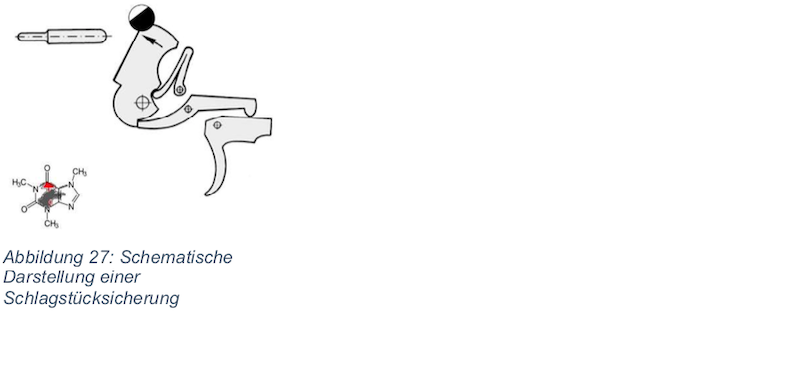
Sicherungen bei Schusswaffen – Die Schlagbolzensicherung
Schlagbolzensicherungen blockieren direkt den Schlagbolzen und bieten damit die größte
Sicherheit.
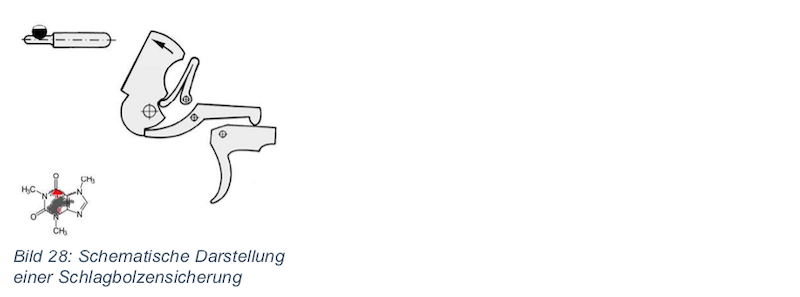
Bei Schusswaffen mit Zylinder- oder Kammerverschluss mit (vertikaler) Flügelsicherung (z.B.
Mauser K98) legt sich bei der Schlagbolzensicherung der Steg des Sicherungsflügels vor die
Schlagbolzenmutter und verhindert so das Vorgleiten des Schlagbolzen. Wird der Sicherungsflügel in den entsicherten Zustand gebracht, dreht sich der Steg entgegen dem Uhrzeigersinn weg und gibt die Schlagbolzenmutter frei. Nun kann ein Schuss abgegeben werden. Der Sicherungsflügel lässt sich nur im gespannten Zustand des Schlosses bedienen. Das Spannen des Schlosses erfolgt beim Öffnen der Kammer. Je nach Position des Sicherungsflügels (Links, Mitte, Rechts) wird die Schlagbolzenmutter blockiert oder freigegeben (siehe Bilder 29 und 30).
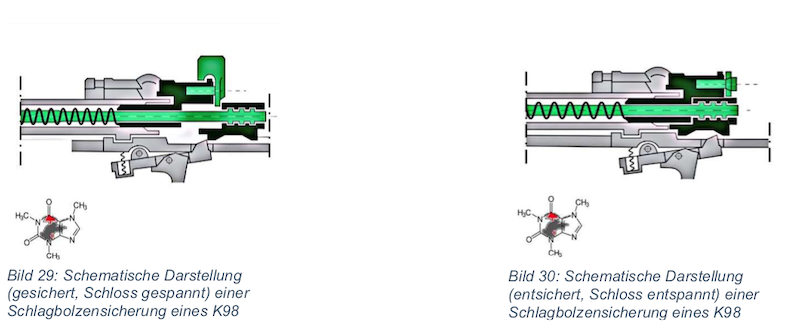
Dabei kann man sich merken:
– Links = Laut – Entsichert (siehe Bild 31)
– Mitte = Montage – Gesichert, Verschluss lässt sich öffnen und schließen (siehe Bild 32)
– Rechts = Ruhe – Gesichert, Verschluss lässt sich nicht öffnen (siehe Bild 33)
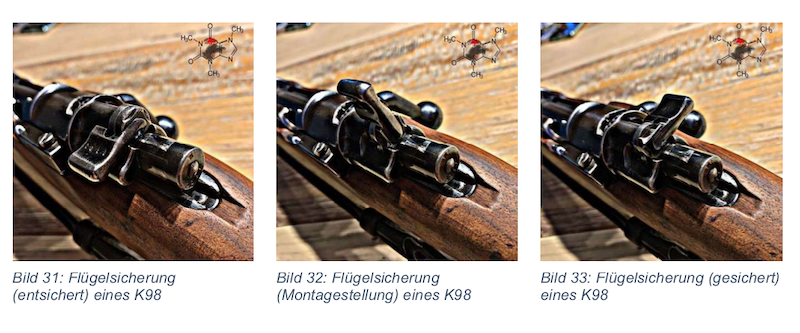
Nachteil der (vertikalen) Flügelsicherung ist, dass bei der Zielfernrohrmontage eine hohe
Montagehöhe genutzt werden muss, da sonst der Sicherungsflügel an dem Okular des
Zielfernrohres anschlägt und sich dadurch die Waffe nicht entsichern bzw. sichern lässt. Um den Nachteil der (vertikalen) Flügelsicherung auszumerzen, wurde eine horizontale 3-Stellung-Sicherung für die 98er Systeme entwickelt (z.B. bei der Mauser M98). Bei Schusswaffen mit Zylinder- oder Kammerverschluss mit (horizontaler) 3-Stellung-Sicherung wirkt bei der Schlagbolzensicherung eine Fangrast auf die Schlagbolzenmutter ein und sichert damit den Schlagbolzen. Wie auch beim vertikalen System lässt sich der Sicherungshebel nur im gespannten Zustand des Schlosses bedienen. Das Spannen des Schlosses erfolgt beim Öffnen der Kammer. Je nach Position des Sicherungshebel (Vorne, Mitte, Hinten) wird die Schlagbolzenmutter blockiert oder freigegeben. Dabei gilt:
– Vorne = Entsichert (siehe Bild 34)
– Mitte = Gesichert, Verschluss lässt sich öffnen und schließen (siehe Bild 35)
– Hinten = Gesichert, Verschluss lässt sich nicht öffnen (siehe Bild 36)
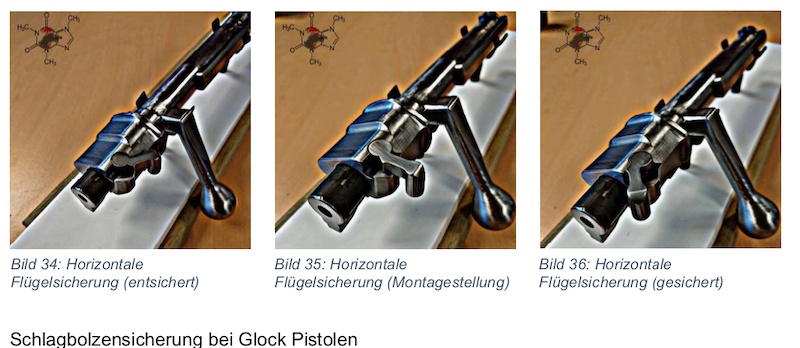
Schlagbolzensicherung bei Glock Pistolen
ie Schlagbolzensicherung ist ein zylindrisches Element im Verschluss des teilvorgespannten Glock-Systems mit einer mittigen Ausnehmung. Bei nicht gezogenem Abzug blockiert sie den Schlagbolzenkanal (siehe Bild 37) und wird erst beim Betätigen des Abzugs mittels der Abzugsstange nach oben gedrückt (siehe Bild 38), so dass der Schlagbolzen dann durch die Ausnehmung gleiten kann. Fällt die Waffe aus großer Höhe, könnte der Schlagbolzen beschleunigt werden, weshalb das Element den Schlagbolzenweg blockiert.
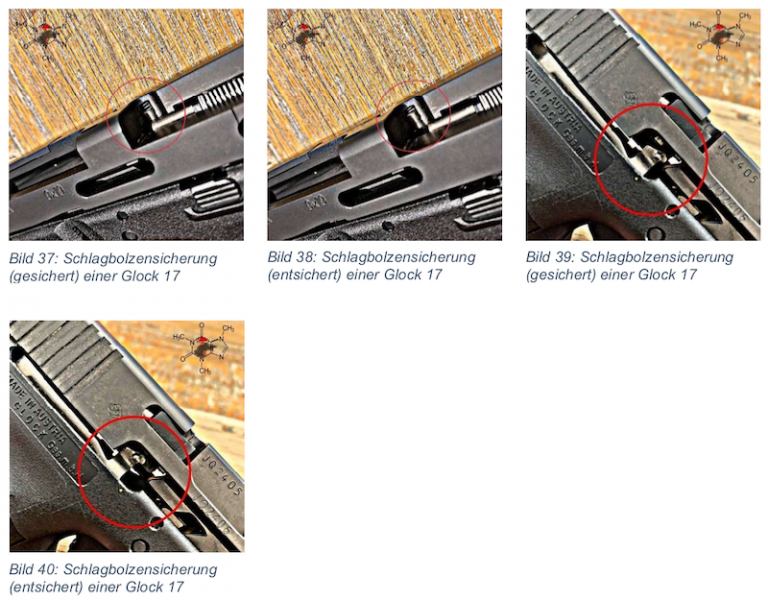
Schlagbolzensicherung bei SigSauer Pistolen
Die Schlagbolzensicherung bei SigSauer Pistolen funktioniert im Prinzip wie die Schlagbolzensicherung bei Glock Pistolen. Sie besteht bei SigSauer Pistolen aus einem quaderförmigen Element im Verschluss des Systems mit einer mittigen Ausnehmung. Bei nicht gezogenem Abzug blockiert sie den Schlagbolzenkanal (siehe Bilder 41 und 43) und wird erst beim Ziehen des Abzugs mittels der Abzugsstange nach oben gedrückt (siehe Bilder 42 und 44), so dass der Schlagbolzen dann durch die Ausnehmung gleiten kann. Fällt die Waffe aus großer Höhe, könnte der Schlagbolzen beschleunigt werden, weshalb das Element den Schlagbolzenweg blockiert.
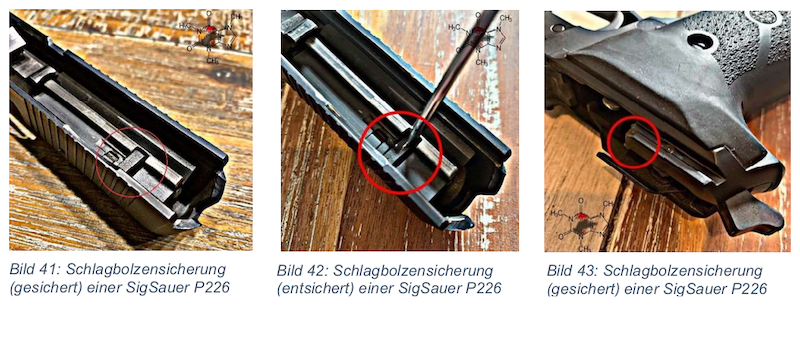
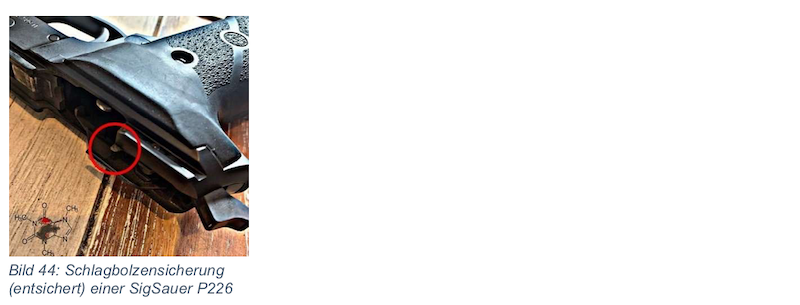
Schlagbolzensicherung bei Heckler & Koch Pistolen
ylindrisches Element im Verschluss des teilvorgespannten Glock-Systems mit einer mittigen Ausnehmung. Bei nicht gezogenem Abzug blockiert sie den Schlagbolzenkanal (siehe Bilder 45 und 47) und wird erst beim Ziehen des Abzugs mittels der Abzugsstange nach oben gedrückt (siehe Bilder 46 und 48), so dass der Schlagbolzen dann durch die Ausnehmung gleiten kann. Fällt die Waffe aus großer Höhe, könnte der Schlagbolzen beschleunigt werden, weshalb das Element den Schlagbolzenweg blockiert.
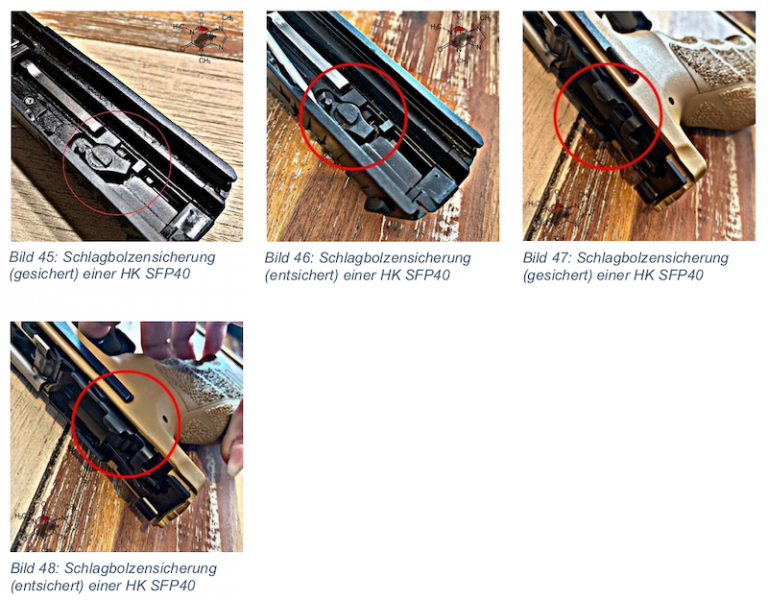
Sicherungen bei Schusswaffen – Die Fallsicherung
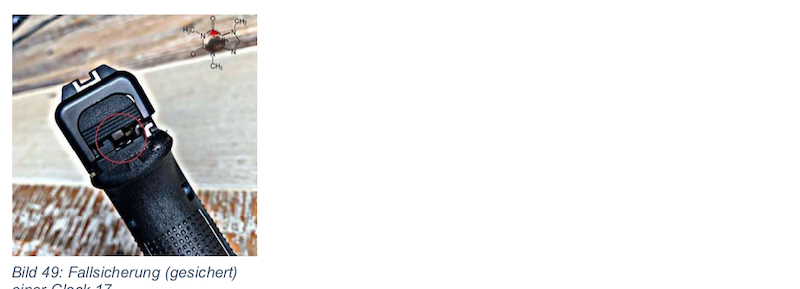
Eine Fallsicherung ist eine automatische (passive) Sicherung, die bei der Einwirkung eines
äußeren Impuls (z.B. beim Sturz der Schusswaffe) eine unbeabsichtigte Schussabgabe
verhindern soll. Sie ist im hinteren Teil des Griffstück angebracht (siehe Bild 49).
Die Fallsicherung bei Glock Safe Action Pistolen ist kein eigenes Bauteil, sondern funktioniert aus dem Zusammenwirken mehrerer Bauteile (z.B. Schlagbolzen, Abzugsstange). Das Ende der Abzugsstange befindet sich in einer Sicherungsrampe innerhalb des Steuerblocks am hinteren Ende des Griffstück (siehe Bild 50) Der Quersteg der Abzugsstange greift in den hinteren Teil des Schlagbolzens ein (siehe Bild 53) und verhindert so, dass der
Schlagbolzen (bei Nichtbetätigen des Abzuges) nach vorne bewegt werden kann. Wenn der
Abzug gezogen wird, senkt sich die Abzugsstange entlang der Sicherheitsrampe und gibt so
den Schlagbolzen frei (siehe Videos 1 und 2).
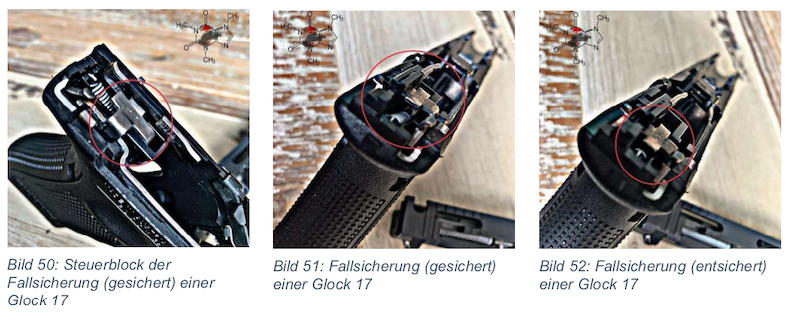
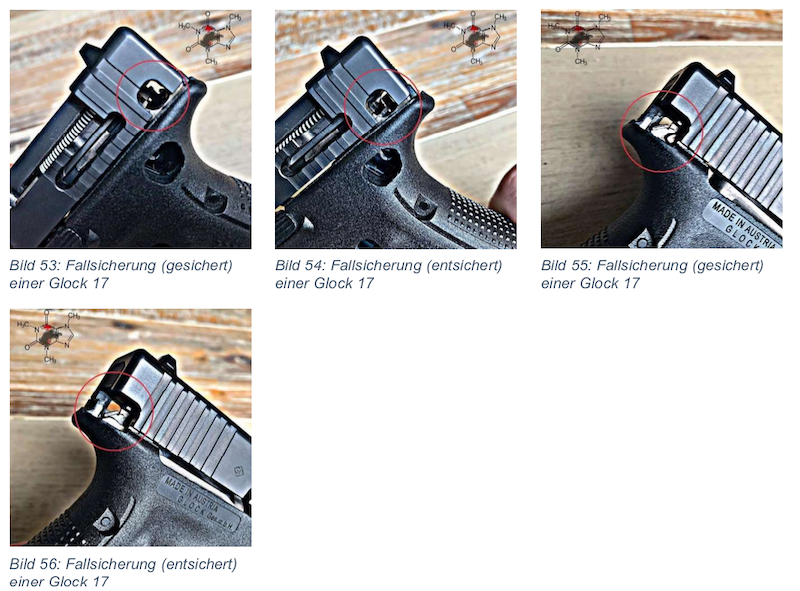
Nach der Schussabgabe bewegt sich die Abzugsstange wieder nach oben und sperrt den Schlagbolzen. Die Schlagbolzenfeder ist dann wieder teilvorgespannt und die Fallsicherung ist wieder aktiv.
WAFFENSICHERUNGEN – Der Artikel von Markus Altoé:
– WAFFENTECHNIK: Das ist meine Sicherung (1)
FORTSETZUNG FOLGT –
Alpha Security Consulting & Training im Internet
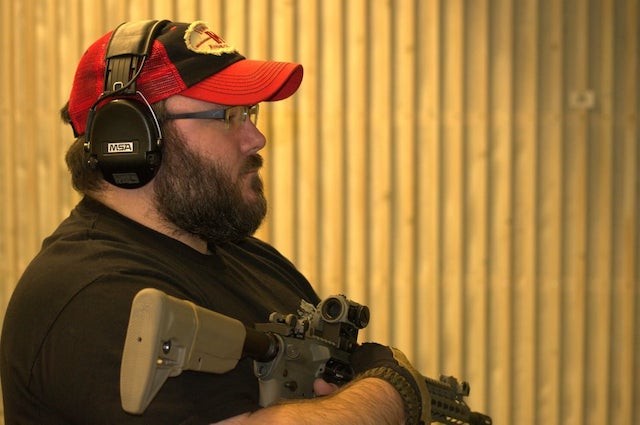
Unvergessen: Markus Altoé – der Nachruf auf SPARTANAT
SPARTANAT ist das Online-Magazin für Military News, Tactical Life, Gear & Reviews.
Schickt uns eure News: [email protected]
Werbung
Hol Dir den wöchentlichen SPARTANAT-Newsletter.
Dein Bonus: das gratis E-Book von SPARTANAT.


